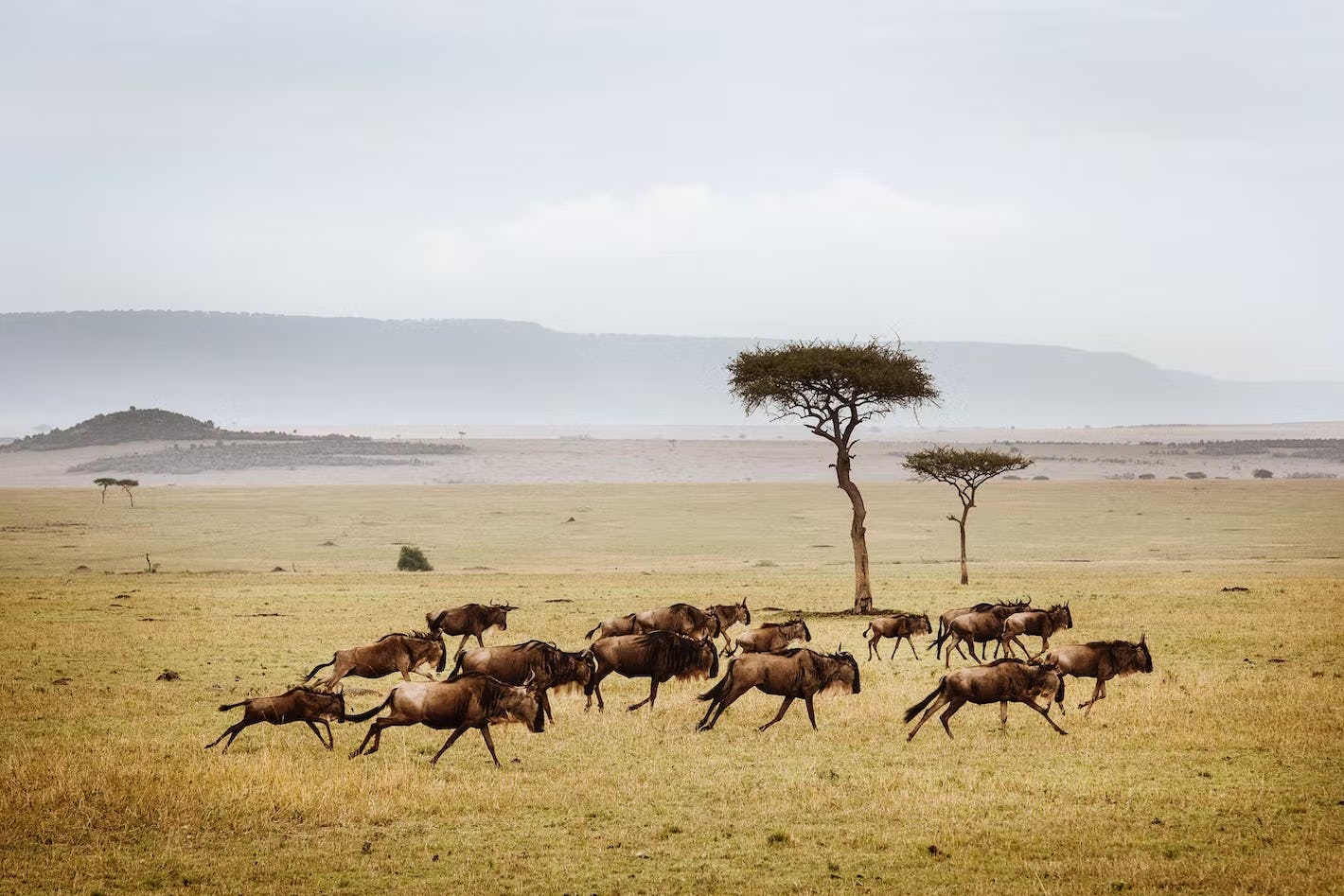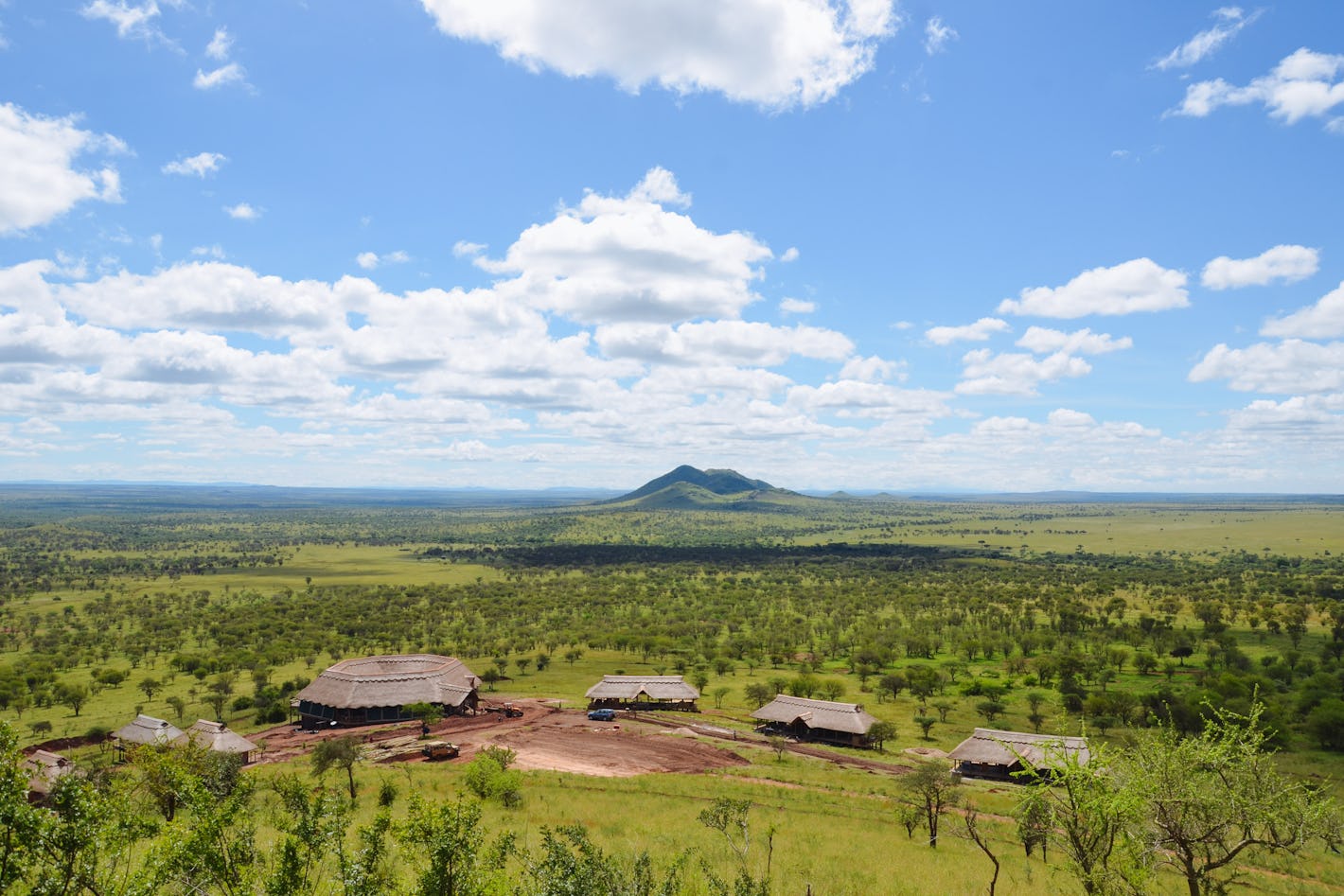
Serengeti Kati Kati Tented Camp
Safari simplicity in an ideal location in the central Serengeti valley.

Chat to an expert
Design your own trip
Customize one of our recommended trips or design your own from scratch

About Serengeti Kati Kati Tented Camp
If you're feeling world-weary, there's no better place to inject yourself with a renewed zest for life than the Seronera region of the Serengeti. Here the spaces are vast, the game abundant, and the sightings reliably good year-round. That's especially true during the wildebeest migration, when the animal action is thrilling (it peaks in May). Kati Kati is a small mobile tented camp that's open all year, except April. You'll see plenty of wildlife roaming through the camp (zebra, elephant, hyena, giraffe, etc.), and the relatively few frills will help you focus on the aim of your journey - a bona fide safari in the wilds of Tanzania.
From $210 person/night
Seronera & Central Serengeti, Serengeti, Tanzania




What you'll love
Enjoy the rustic simplicity of the tented rooms and savour that hot bucket shower until its last drop, knowing that you're playing your part in making the camp's footprint is as small as it can be.
Insiders tip
Full-day outings spent exploring this vast territory are a fabulous way to immerse yourself in the African wilderness. Food-lovers will be happy too – the picnic lunches provided are plentiful and delicious.
Something to think about
Kati Kati is one of the more rustic safari camps in the Serengeti, but it's still comfortable and really, the phenomenal location in the Central Serengeti valley is all that matters.
/34.757322,-2.481352,7/620x353@2x?access_token=pk.eyJ1IjoidGltYnVrdHV0cmF2ZWwiLCJhIjoiY2poMGw1eHpkMmRkbDJ6bW8xYWZ5OGpjYyJ9.PYvAO7lUJ40SOpGvwmQLqw&attribution=false&logo=false)
The property
The only communal areas are the dining tent and the campfire. The former is a canvas tent with mesh windows and roll-up sides. It's smartly set with table cloths and good linens for every meal. Evening meals are generally served at communal tables, dressed up with candles and old-fashioned oil lanterns – all very romantic and convivial. The campfire is where guests convene for drinks, snacks and stories before dinner, and to enjoy nightcaps before heading to bed.
The rooms
Kati Kati's 10 double tents and one family tent are arranged in a long row. Although they're not especially private, they're sufficiently roomy and have comfortable beds. At the rear of each tent is a bathroom with a chemical flush toilet and 20-litre bucket shower, which is filled by staff. There are no plug points (you can charge batteries in the main area) and lighting can be quite dim, though adequate. In front is a small covered veranda with chairs.
Activities
This region is one of the busiest in the park because the vast, open savanna is perfect for viewing cheetah and other big cats, as well as elephant and plains game. May is the pinnacle of the migration period, although the animals don't follow a strict schedule and huge herds can be seen almost year-round. The camp is situated an hour’s drive from Olduvai, the important archaeological site where Louis and Mary Leakey made their fascinating discoveries, and is well worth a visit. Twice-daily game drives are offered, as are hot-air balloon rides (followed by a champagne brunch) and a visit to meet local Maasai villagers. Magic!
Positive impact
The organisation supports various community projects, including the de-snaring project in the Serengeti, medical care solutions like the Olmoti Clinic in Western Kilimanjaro, and educational opportunities like the Emusoi Centre in Arusha. Additionally, initiatives like the Children’s Health Program in Nairobi and contributions to Wildlife Management Areas and Tanzania National Parks underscore their commitment to community well-being and environmental conservation.
Reviews
About Serengeti
Wildlife in Serengeti
Show all wildlife
The Serengeti National Park is an ecologically rich environment and home to vast herds of wildebeest, zebra, Thomson's gazelle and buffalo grazing on the sweet grasses of the savannah. Even after the Great Migration has moved through, the game viewing is exceptional in this region. The predators are never far off, with cheetah and lion in abundance and leopard readily seen in the Seronera region of the Central Serengeti. Enjoy expansive grasslands, acacia thickets, meru kopjes (granitic hills) and riverine forests.
More properties in Serengeti
What our guests are saying
Design your own trip
Choose a destination, pick your properties, and we'll do the rest
Design a tripNeed a hand?
hello@timbuktutravel.com +44 (0)203 8083 860 +1 (646) 542 0667 +27 (0)21 201 7253 Live chat






,url-https%3A%2F%2Fwaybird.imgix.net%2Fimages%2Fmap%2Fmarker_yellow.png%3Fw%3D22(36.923886,-1.322705),url-https%3A%2F%2Fwaybird.imgix.net%2Fimages%2Fmap%2Fmarker_blue.png%3Fw%3D22(36.918046,-1.341462),url-https%3A%2F%2Fwaybird.imgix.net%2Fimages%2Fmap%2Fmarker_blue.png%3Fw%3D22(30.064840,-1.946951),url-https%3A%2F%2Fwaybird.imgix.net%2Fimages%2Fmap%2Fmarker_blue.png%3Fw%3D22(29.615676,-1.438784),url-https%3A%2F%2Fwaybird.imgix.net%2Fimages%2Fmap%2Fmarker_blue.png%3Fw%3D22(36.803516,-1.327864),url-https%3A%2F%2Fwaybird.imgix.net%2Fimages%2Fmap%2Fmarker_blue.png%3Fw%3D22(36.859929,-0.042587),url-https%3A%2F%2Fwaybird.imgix.net%2Fimages%2Fmap%2Fmarker_blue.png%3Fw%3D22(36.052233,-0.437849),url-https%3A%2F%2Fwaybird.imgix.net%2Fimages%2Fmap%2Fmarker_blue.png%3Fw%3D22(35.060199,-1.450359),url-https%3A%2F%2Fwaybird.imgix.net%2Fimages%2Fmap%2Fmarker_yellow.png%3Fw%3D22(36.923886,-1.322705)/auto/72x72@2x?access_token=pk.eyJ1IjoidGltYnVrdHV0cmF2ZWwiLCJhIjoiY2poMGw1eHpkMmRkbDJ6bW8xYWZ5OGpjYyJ9.PYvAO7lUJ40SOpGvwmQLqw&attribution=false&logo=false)
,url-https%3A%2F%2Fwaybird.imgix.net%2Fimages%2Fmap%2Fmarker_yellow.png%3Fw%3D22(25.837811,-18.094167),url-https%3A%2F%2Fwaybird.imgix.net%2Fimages%2Fmap%2Fmarker_blue.png%3Fw%3D22(25.818166,-17.927454),url-https%3A%2F%2Fwaybird.imgix.net%2Fimages%2Fmap%2Fmarker_blue.png%3Fw%3D22(26.483370,-18.871828),url-https%3A%2F%2Fwaybird.imgix.net%2Fimages%2Fmap%2Fmarker_blue.png%3Fw%3D22(27.461339,-19.078352),url-https%3A%2F%2Fwaybird.imgix.net%2Fimages%2Fmap%2Fmarker_yellow.png%3Fw%3D22(25.837811,-18.094167)/auto/72x72@2x?access_token=pk.eyJ1IjoidGltYnVrdHV0cmF2ZWwiLCJhIjoiY2poMGw1eHpkMmRkbDJ6bW8xYWZ5OGpjYyJ9.PYvAO7lUJ40SOpGvwmQLqw&attribution=false&logo=false)
,url-https%3A%2F%2Fwaybird.imgix.net%2Fimages%2Fmap%2Fmarker_yellow.png%3Fw%3D22(36.923886,-1.322705),url-https%3A%2F%2Fwaybird.imgix.net%2Fimages%2Fmap%2Fmarker_blue.png%3Fw%3D22(36.918046,-1.341462),url-https%3A%2F%2Fwaybird.imgix.net%2Fimages%2Fmap%2Fmarker_blue.png%3Fw%3D22(35.035357,-1.234536),url-https%3A%2F%2Fwaybird.imgix.net%2Fimages%2Fmap%2Fmarker_yellow.png%3Fw%3D22(36.923886,-1.322705)/auto/72x72@2x?access_token=pk.eyJ1IjoidGltYnVrdHV0cmF2ZWwiLCJhIjoiY2poMGw1eHpkMmRkbDJ6bW8xYWZ5OGpjYyJ9.PYvAO7lUJ40SOpGvwmQLqw&attribution=false&logo=false)
,url-https%3A%2F%2Fwaybird.imgix.net%2Fimages%2Fmap%2Fmarker_yellow.png%3Fw%3D22(32.436430,0.042443),url-https%3A%2F%2Fwaybird.imgix.net%2Fimages%2Fmap%2Fmarker_blue.png%3Fw%3D22(32.467550,0.055645),url-https%3A%2F%2Fwaybird.imgix.net%2Fimages%2Fmap%2Fmarker_blue.png%3Fw%3D22(31.573253,2.290126),url-https%3A%2F%2Fwaybird.imgix.net%2Fimages%2Fmap%2Fmarker_blue.png%3Fw%3D22(30.394046,0.431828),url-https%3A%2F%2Fwaybird.imgix.net%2Fimages%2Fmap%2Fmarker_blue.png%3Fw%3D22(29.899825,-0.188428),url-https%3A%2F%2Fwaybird.imgix.net%2Fimages%2Fmap%2Fmarker_blue.png%3Fw%3D22(29.711680,-0.619822),url-https%3A%2F%2Fwaybird.imgix.net%2Fimages%2Fmap%2Fmarker_blue.png%3Fw%3D22(29.616627,-0.986596),url-https%3A%2F%2Fwaybird.imgix.net%2Fimages%2Fmap%2Fmarker_yellow.png%3Fw%3D22(32.436430,0.042443)/auto/72x72@2x?access_token=pk.eyJ1IjoidGltYnVrdHV0cmF2ZWwiLCJhIjoiY2poMGw1eHpkMmRkbDJ6bW8xYWZ5OGpjYyJ9.PYvAO7lUJ40SOpGvwmQLqw&attribution=false&logo=false)
,url-https%3A%2F%2Fwaybird.imgix.net%2Fimages%2Fmap%2Fmarker_yellow.png%3Fw%3D22(36.923886,-1.322705),url-https%3A%2F%2Fwaybird.imgix.net%2Fimages%2Fmap%2Fmarker_blue.png%3Fw%3D22(36.702587,-1.341083),url-https%3A%2F%2Fwaybird.imgix.net%2Fimages%2Fmap%2Fmarker_blue.png%3Fw%3D22(36.982322,0.018325),url-https%3A%2F%2Fwaybird.imgix.net%2Fimages%2Fmap%2Fmarker_blue.png%3Fw%3D22(32.455046,0.035545),url-https%3A%2F%2Fwaybird.imgix.net%2Fimages%2Fmap%2Fmarker_blue.png%3Fw%3D22(29.614122,-0.997344),url-https%3A%2F%2Fwaybird.imgix.net%2Fimages%2Fmap%2Fmarker_yellow.png%3Fw%3D22(32.436430,0.042443)/auto/72x72@2x?access_token=pk.eyJ1IjoidGltYnVrdHV0cmF2ZWwiLCJhIjoiY2poMGw1eHpkMmRkbDJ6bW8xYWZ5OGpjYyJ9.PYvAO7lUJ40SOpGvwmQLqw&attribution=false&logo=false)
,url-https%3A%2F%2Fwaybird.imgix.net%2Fimages%2Fmap%2Fmarker_yellow.png%3Fw%3D22(30.135109,-1.963502),url-https%3A%2F%2Fwaybird.imgix.net%2Fimages%2Fmap%2Fmarker_blue.png%3Fw%3D22(30.064840,-1.946951),url-https%3A%2F%2Fwaybird.imgix.net%2Fimages%2Fmap%2Fmarker_blue.png%3Fw%3D22(29.537320,-1.415555),url-https%3A%2F%2Fwaybird.imgix.net%2Fimages%2Fmap%2Fmarker_blue.png%3Fw%3D22(35.123917,-2.557361),url-https%3A%2F%2Fwaybird.imgix.net%2Fimages%2Fmap%2Fmarker_blue.png%3Fw%3D22(35.658875,-2.963298),url-https%3A%2F%2Fwaybird.imgix.net%2Fimages%2Fmap%2Fmarker_yellow.png%3Fw%3D22(37.074444,-3.429167)/auto/72x72@2x?access_token=pk.eyJ1IjoidGltYnVrdHV0cmF2ZWwiLCJhIjoiY2poMGw1eHpkMmRkbDJ6bW8xYWZ5OGpjYyJ9.PYvAO7lUJ40SOpGvwmQLqw&attribution=false&logo=false)




